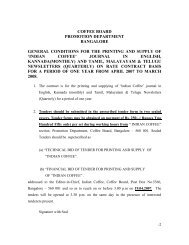COFFEE CULTIVATION GUIDE - Coffee Board of India
COFFEE CULTIVATION GUIDE - Coffee Board of India
COFFEE CULTIVATION GUIDE - Coffee Board of India
Create successful ePaper yourself
Turn your PDF publications into a flip-book with our unique Google optimized e-Paper software.
CULTURAL OPERATIONS TO BE CARRIED OUT DURING<br />
OCTOBER-NOVEMBER MONTHS<br />
1. Weed Control<br />
2. Cleaning <strong>of</strong> pulper and Drying Yards<br />
3. Arabica <strong>C<strong>of</strong>fee</strong> Harvesting<br />
4. <strong>C<strong>of</strong>fee</strong> Processing<br />
(a) Arabica Parchment Preparation<br />
(b) Arabica Cherry Preparation<br />
5. Seed <strong>C<strong>of</strong>fee</strong> Preparation<br />
6. White Stem Borer Control<br />
7. Soil Testing and Liming<br />
8. Soil Digging (Cover digging)<br />
9. <strong>C<strong>of</strong>fee</strong> Effluent Management<br />
10. Opening <strong>of</strong> Cradle Pits<br />
11. Hutting<br />
1. Weed Control<br />
30<br />
***********<br />
Different types <strong>of</strong> weeds grow in c<strong>of</strong>fee estates and they compete with c<strong>of</strong>fee<br />
plants for moisture and mineral nutrients. If the weeds are allowed to grow during the<br />
late post-monsoon period, they use the soil moisture which c<strong>of</strong>fee plants need in the<br />
following dry season. Free growth <strong>of</strong> weeds reduces the yield <strong>of</strong> c<strong>of</strong>fee plants as well<br />
as their growth. Therefore, it very important to control the weeds in the field. In<br />
young plantations weeds are the major problems during the initial years. In new<br />
clearings, the weeds should be removed by slash weeding at least 3-4 times in a year.<br />
While in established fields, 2-3 times this operation has to be carried out. All the<br />
slashed weeds should be spread in the field during the rainy season for rotting and<br />
bio-degradation. Weeds which have the habit <strong>of</strong> flowering should be removed before<br />
they flower. After the monsoon, clean weeding should be done in the entire estate.<br />
In established plantations, recommended weedicides can also be used. But one<br />
should note that, the sprayers used for spraying weedicides should never be used for<br />
spraying any other chemicals without ensuring 100% cleaning. Use WFN 062 or<br />
WFN 040 flood jet nozzles for spraying weedicides. The use <strong>of</strong> weedicides should be<br />
judicious and as far as possible the use should be restricted to the most minimum level<br />
to avoid environmental contamination. Weedicides along with wetting agent should<br />
be applied on a bright sunny day when there is sufficient moisture. The soil moisture<br />
helps the faster absorption <strong>of</strong> the weedicides by the weeds.<br />
In the new clearing, the fields should be given a thorough cover digging to a<br />
depth <strong>of</strong> 9 inches towards the end <strong>of</strong> monsoon and all weeds, vegetative wastes and<br />
debris should be completely turned over and buried into the soil. In young clearings,<br />
c<strong>of</strong>fee planted at normal spacing covers only a small portion <strong>of</strong> the ground and<br />
therefore weeds grow prolifically. In such spaces growing <strong>of</strong> green manure crops,<br />
cover crops, legumes, beans, pigeon peas, sweet potato and vegetables are<br />
recommended as these plants hinder the growth <strong>of</strong> weeds. The crop from these plants<br />
can either be harvested or these plants can be cut and incorporated in the soil again. In<br />
2-4 year old plantations, the soil has to be scuffled to a depth <strong>of</strong> 0.25 inches (7.5 cm)<br />
or cover crops have to be grown.<br />
30














